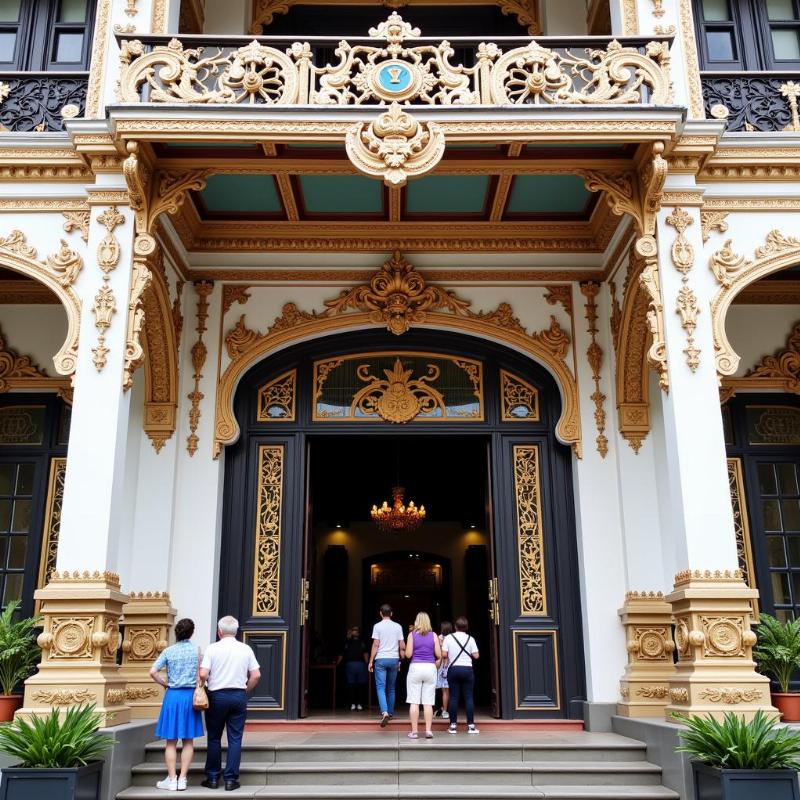Malacca, a UNESCO World Heritage city, overflows with history, culture, and delectable food. Whether you’re a history buff, a foodie, or just seeking a unique travel experience, things to do in Malacca are plentiful and diverse. From exploring ancient ruins to indulging in Peranakan cuisine, Malacca promises an unforgettable adventure. Let’s dive into the myriad of experiences this charming Malaysian city offers.
Discover Malacca’s Historical Gems
Malacca’s rich history is palpable everywhere you turn. Start your exploration at the iconic A Famosa fort, a remnant of Portuguese colonization. Climb St. Paul’s Church for panoramic city views and imagine the echoes of past sermons. Don’t miss the Stadthuys, a vibrant red building that housed the Dutch administrative center. These landmarks offer a glimpse into Malacca’s fascinating past and its pivotal role in Southeast Asian trade.
What makes these historical sites even more compelling are the stories they tell. Imagine the battles fought, the treaties signed, and the cultural exchanges that shaped this vibrant city.
Take a leisurely stroll along the Malacca River, once a bustling trade route. The colorful trishaws, adorned with bright lights and music, offer a unique way to experience the city’s charm. As you glide along the riverbanks, observe the traditional shophouses and imagine the vibrant trade that once flourished here.
Indulge in Malacca’s Culinary Delights
No trip to Malacca is complete without savoring its diverse culinary scene. The city’s Peranakan heritage, a blend of Chinese and Malay cultures, has given rise to a unique cuisine. Sample Nyonya laksa, a rich and flavorful coconut milk-based noodle soup. Indulge in chicken rice balls, a Malacca specialty, and savor the fragrant flavors.
For a sweet treat, try the cendol, a refreshing shaved ice dessert with coconut milk and palm sugar. The vibrant street food scene offers a plethora of options for every palate and budget. From savory snacks to sweet treats, Malacca is a food lover’s paradise.
Where can you find these culinary delights? Wander through Jonker Street, a bustling night market that comes alive with food stalls and local crafts. Explore the hidden alleys and discover local eateries serving authentic Peranakan dishes.
Experience Malacca’s Cultural Tapestry
Beyond its history and food, Malacca boasts a rich cultural tapestry. Visit the Baba & Nyonya Heritage Museum for a glimpse into the Peranakan culture. Admire the intricate architecture and ornate furnishings of these traditional houses. Explore the Cheng Hoon Teng Temple, the oldest Chinese temple in Malaysia, and witness the vibrant religious practices.
What makes Malacca so culturally rich? The city’s history as a melting pot of different cultures has created a unique blend of traditions and customs. This cultural diversity is reflected in the city’s architecture, food, and festivals.
 The Baba & Nyonya Heritage Museum showcases the rich Peranakan culture of Malacca.
The Baba & Nyonya Heritage Museum showcases the rich Peranakan culture of Malacca.
Conclusion
From exploring historical landmarks to indulging in culinary delights and immersing yourself in the local culture, things to do in Malacca are abundant and varied. This vibrant Malaysian city promises a unique and unforgettable travel experience for every visitor. So, pack your bags and embark on an adventure to discover the magic of Malacca.
FAQ
- What is the best time to visit Malacca? The best time to visit Malacca is during the dry season, from November to April.
- How do I get to Malacca? You can reach Malacca by bus, train, or car from Kuala Lumpur or Singapore.
- What is the currency in Malacca? The currency in Malacca is the Malaysian Ringgit (MYR).
- What language is spoken in Malacca? The official language is Bahasa Malaysia, but English is widely spoken.
- Is Malacca safe for tourists? Malacca is generally safe for tourists, but it’s always wise to be mindful of your belongings.
- What are some must-try dishes in Malacca? Nyonya Laksa, Chicken Rice Balls, and Cendol are some must-try dishes.
- Where can I find souvenirs in Malacca? Jonker Street is a great place to find souvenirs and local crafts.